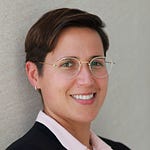In this episode, activists Matthew Metz and Janelle London discuss their new report on gasoline “superusers” — the subset of drivers who drive long distances each year — and the policy recommendations around EV subsidies that it contains. It's a clever idea I haven't been able to stop thinking about.
Full transcript of Volts podcast featuring Matthew Metz & Janelle London, April 4, 2022
David Roberts:
Over the last week I’ve been doing a series of podcasts about clever ways to reduce oil and gas consumption, which these days seems like a pretty patriotic thing to do. The first two were about buildings — how to make them more efficient and get them off of natural gas.
Today we’re talking about gasoline. Specifically, we’re talking about the people who use the most gasoline and how we might get them into electric vehicles (EVs).
Last year, a nonprofit called Coltura, devoted to reducing gasoline consumption, issued a report about “gasoline superusers,” a relatively small percentage of drivers who use a disproportionate amount of gasoline. It also contained a proposal for how to revise US EV subsidies to target superusers, thus displacing the maximum amount of gasoline use.
It’s an intriguing proposal, a new way to think about EV policy, so given the present geopolitical importance of reducing demand, I thought it would be a good time to kick the tires (pardon the pun). I’m excited to talk to Matthew Metz and Janelle London, the co-executive directors of Coltura, about who these superusers are, how we can best identify them, and what it would mean to scale EV subsidies in their direction.
So without further ado, Matthew Metz and Janelle London, welcome to Volts. Thanks for coming.
Janelle London:
Thank you so much for having us.
Matthew Metz:
Great to be here.
David Roberts:
The use of gasoline in the US, unlike use of fossil fuel electricity, is not declining, despite technological and efficiency gains. Why is US gasoline use so persistently high?
Matthew Metz:
There are a number of reasons. There are more drivers on the road; they're driving longer distances; and they're driving bigger vehicles. We have been getting some gasoline savings from more efficient vehicles, but that's all been canceled out by more vehicles and driving further. In 2006, we used 140 billion gallons a year of gasoline; right now it's roughly around the same. We haven't made any progress.
David Roberts:
How much of our greenhouse gas emissions in the US are gasoline, or due to transportation?
Matthew Metz:
Eighteen percent come from light duty vehicles, so basically gasoline. And 29 percent of total US emissions are from transportation.
David Roberts:
You’ve been researching specifically who is using gasoline. Let’s talk about the data set that you drew on: what's in there, what we can learn from it, what sorts of things we could possibly learn with better data, or what better data might someday be available.
Janelle London:
We got our data from something called the National Household Travel Survey. It's done by the Federal Highway Administration, and it had 130,000 respondents, so that's a pretty rich source of data. We were able to learn a lot of general information about gasoline use from this survey: who's using it, how much, and where.
David Roberts:
Is it literally a survey that they sent to people? You just fill out and report your own gasoline use?
Janelle London:
That's right. You point out a great limitation – it's only as accurate as the survey takers’ responses.
David Roberts:
It's not measuring things; it's asking people's recollections of things.
Janelle London:
Correct. The last one was in 2017. It looks like there's another one coming out this year, so we will get much more recent data coming soon.
David Roberts:
What range of data do they end up drawing out?
Matthew Metz:
There's a broad range of data. It's basically everything you did on a certain day of the year. Did you take the bus that day? Did you carpool? Did you walk, bike? It goes into pretty comprehensive detail, and it's really the Rosetta Stone for how the US transportation system actually works.
David Roberts:
What was the main finding of the report? What's a superuser, and how much gas do these superusers account for?
Janelle London:
We defined superuser as somebody who is in the top 10 percent of gasoline consumption in the US. Those folks account for about 42 billion gallons of gas. Although by definition they're the top 10 percent of gasoline consumers, they account for about 32 percent of all the gasoline.
David Roberts:
This is a familiar pattern, where you get the bulk of usage from a relatively concentrated number of users.
Janelle London:
If you take it one step further, the top 20 percent account for about half of all the gasoline. Gasoline use is concentrated in these top tiers.
Matthew Metz:
The superusers in the United States consume as much gasoline as the entire countries of UK, France, Italy, and South Korea combined.
David Roberts:
So we have this 10 percent that use strikingly more gasoline than the lower 50 to 60 percent of the distribution. What do we know about those people? Who are they? Where are they? What do they do for a living? What's the extent of our knowledge about them currently?
Matthew Metz:
When we look at the map in terms of where superusers are concentrated, it looks kind of like a red and blue state map. The red areas are the southern part of the country and the Midwest. Oklahoma, Texas, and Louisiana are right at the top of superusers. That's where they're the most concentrated.
Then along the coast they’re in the least concentration. That's the opposite of the EV map, where the EVs are really concentrated on the coast in the traditional blue areas and pretty sparse in red America.
David Roberts:
How precisely can we locate them? Do we know what percentage of them are rural vs. urban or suburban?
Matthew Metz:
About a third are rural, compared to about 26 percent of other drivers. So they’re somewhat more likely to be rural, but really, they're located everywhere. They're in small towns and suburbs in relatively similar proportions to other drivers. But they are definitely the most concentrated in the rural areas.
David Roberts:
Beyond where they are, do we know who they are – their income or profession or anything like that?
Janelle London:
There was an income breakdown. There were superusers across all income levels, but they were more concentrated in the lower income levels.
In terms of what they drove, we found that they tended to drive – no big surprise – the bigger vehicles like trucks and SUVs.
Matthew Metz:
They're weighted toward trucks and SUVs, but there are still many millions of car drivers as well.
David Roberts:
So it's fair to say they're slightly weighted rural, lower income, bigger trucks and SUVs – but only slightly. It's still distributed pretty evenly.
Matthew Metz:
That's true. Even going back to the geography, while it's true that they're more in red states, there are plenty in California. In the blue states, there are millions. In Texas, the superusers use about 35 percent of all gasoline, and in California, they use 25 percent.
David Roberts:
At a very basic level, do we know why these people are driving so much?
Janelle London:
We have some pretty strong theories. By the type of vehicle that superusers are driving and where they're located, we figured out that they're usually either super-commuters who are having to commute extremely long distances to work in less efficient vehicles, or they may be in construction where they have to drive around to different construction sites, again in bigger vehicles.
Those were the main two use cases that we identified, although I'm sure there are more along the edges that we're not entirely sure about.
Matthew Metz:
There are interesting regional variations there as well. For example, there are quite a few superusers in the Palo Alto area – wealthy enclaves, cars that are probably used to transport children around. That's the leading category, the minivans and things like that.
David Roberts:
Your basic proposal is that we should be targeting EV subsidies at these gasoline superusers. Let's start by getting a picture in our heads of where EV subsidies are currently going, because right now, they're not weighted at all, for anything. So where do they end up going? What does the map look like for where EV subsidies are concentrated now?
Janelle London:
What we're finding is that generally EV subsidies are being used by wealthier people who tend to be on the lower end of gasoline use, so these EVs aren't displacing that much gasoline. We can tell that because there are heavy concentrations of EV buyers in the wealthiest ZIP codes.
Up to very recently, pretty much everyone was eligible to get incentives for EVs. Unfortunately, there's a big mismatch between the current recipients of these EV subsidies and superusers.
David Roberts:
I guess it makes some intuitive sense that if you're the type of person who will be an early EV adopter, you're probably already the type of person to not drive so much.
Janelle London:
It’s possible. In the early days before there was so much public EV charging and there were still a lot of myths prevailing about EVs, it took courage for the really early adopters to go for these cars. Of course, they tended to be wealthier people who could afford to add a third car in the driveway but didn’t have to rely on it.
But EVs are becoming quite mainstream, to where anyone can use one, and we're starting to see that in areas.
Matthew Metz:
A lot of EVs were appealing to raging environmentalists that used to drive a Prius, and now were going to do even better. But those people, again, were not using lots of gasoline, because Priuses are quite efficient.
David Roberts:
Your basic proposal is that we should be scaling those EV subsidies toward gasoline superusers – or, in general, you should get more EV subsidy the more gasoline you typically burn.
What are the mechanics? Say I go to a GM dealer, I want to buy a Bolt, and I'm going to get a scaled subsidy. Who calculates how much I've driven and what my typical gasoline consumption is? Who does the scaling and who gives me the subsidy? How does the math work?
Janelle London:
It's actually pretty easy. At the time you register your gas-powered vehicle, there's an odometer reading that is on that certificate of title. That can easily be obtained through services like Carfax, or you can just go look at your own title.
Imagine you go in to the dealer, take your certificate of title, and you've got your car. They look at your current odometer reading and subtract the starting odometer reading from that current one, and they can get the total miles that you've traveled in the lifetime of your ownership of the vehicle. From that, they can divide by how many years you've had the vehicle and your miles per gallon rating of that particular vehicle, which is also very easily available. That will give you your average annual gallons of gasoline burned over the time you've had the vehicle.
Then they can assign whatever the government decides is the correct dollar value per average annual gallon. For math simplicity, say it's $10 a gallon. If you're a superuser, that means you're on average burning about 1,000 gallons a year or more. So if it was $10 a gallon, you would get $10,000 to trade in that car for an electric vehicle.
David Roberts:
Inversely, I drive very little, and would get very little off of the price of the new vehicle.
Janelle London:
That's right. You'd still get something, unless the government would set up this incentive program so that below a certain number of gallons, you get nothing. If they wanted to incentivize everyone, you would get something, but it'd be a lot less than people who are burning tons and tons of gasoline.
For equity, it would be very helpful to give a boosted amount per average gallon to lower-income drivers. They're having to spend a ridiculous percent of their household income on gasoline, especially if they're superusers, so they should actually get more to make the switch.
David Roberts:
Although this probably won't be true for much longer, EVs are still more expensive in terms of sticker price. If you're a low-income gasoline superuser, you may have a beater, and you may only be able to afford a new beater. The incentives would have to be pretty steep, wouldn't they, to get at some of these people on the lower end of the income scale?
Matthew Metz:
It depends on how much gasoline they're using. With gasoline at $6 a gallon, as it is in much of California and elsewhere, it actually makes sense for pretty much any superuser to switch to EV. There may be some gap, but an EV subsidy can cover a great deal of that. It really can make sense.
Janelle London:
If you think about the monthly amount a low-income superuser is having to save out to pay for their gasoline, and suddenly they're going to get a pretty deep discount on an EV, maybe they're still going to have to make a monthly payment, but they're now not paying that much for their fuel. The electricity is going to be anywhere from a fifth to half of the cost of gasoline. Suddenly, they've got money back in their pocket that they could use to make those monthly payments.
David Roberts:
Have you thought about extending EV subsidies to used EVs? That would be one way to bring the range of eligible vehicles down much cheaper.
Matthew Metz:
That's a good idea. The point is to get superusers driving electric vehicles, so if that's a used vehicle or new vehicle, great.
Janelle London:
The point is to displace gasoline. We've got this goal out there to cut emissions from all sources in half by 2030. For the light duty vehicle sector, the whole point is to displace gasoline as fast as we can. We don't really care what the driver switches to, as long as they're cutting their gasoline use by, hopefully, a big margin.
David Roberts:
If we envision a rural gasoline superuser driving their big truck around to jobs all over their rural counties, is there an EV that can cover those needs? Aren't the people who drive the longest distances the ones that are most likely to run into range issues, or range anxiety, or difficulty finding an EV that has the capacity or the range to cover their needs?
Janelle London:
No. There are so many superusers of all different stripes that, at least for starters, we could start getting superusers into EVs who are the perfect candidates for right this second. Electric pickup trucks are coming, they're just a few years away. But for now, even people who are driving sedans could switch to something like a Chevy Bolt.
The average superuser mileage is about 30,000 miles per year. Somebody driving 100-120 miles a day could easily qualify as a superuser. Most electric vehicles today have 200-250 miles of range. If you're the type of superuser who drives 120 miles a day and you come home every night and could charge your car overnight, you're already a fantastic candidate to make the switch and it's not going to be a big deal.
Matthew Metz:
One advantage that rural drivers have is usually they can plug in at home. That makes it super easy for them to charge.
David Roberts:
You’ve figured out that if we scaled EV subsidies this way, we could reduce much more gasoline with way fewer EVs. How does that math work out, and how big is that difference?
Matthew Metz:
It's pretty big. If we were able to get the 98 million biggest users of gasoline into EVs, that would enable us to cut our carbon emissions by 50 percent. That would lead to about a 65 percent decrease in gasoline.
If you took the 233 million least users in the country, that's how many EVs it would take: 233 million. Basically, almost two and a half times as many EVs would be required if we helped the lower users first, as opposed to the bigger users.
David Roberts:
Insofar as we're thinking about this being a fast way to reduce gasoline use, how big an issue are supply problems right now? Do you think that they’ll catch up by the time demand would ramp up from this kind of thing?
Janelle London:
You're right that right now there is a supply chain issue and a struggle to meet the demand. Auto manufacturers are making huge plans to ramp up – they want to be able to meet this demand for EVs.
What it highlights is that right now, while we have demand exceeding the supply for EVs, it makes it even more critical that we get those precious EVs, each of which has the potential to displace enormous amounts of gasoline, into the hands of the people who were burning that gasoline.
Matthew Metz:
Another way of saying it is, how dumb is it for the government to give a bunch of money to people who aren't using their EV very much when those people would obviously buy it anyway because there's such strong demand for it? The market-making function of EV subsidies, which made a lot of sense 10 years ago, right now makes zero sense.
David Roberts:
There's an argument that there's gasoline reduction policy, and there's EV policy, and they're not necessarily the same thing. You could say that EV policy is industrial policy: the point is to create the market and drive scale in a market, and to do that, you want to get the most EVs out the door that you can. Are you saying, Matthew, that we did that part already?
Matthew Metz:
That's right. And when supplies are so tight, you can't get any more EVs built because there's a supply constraint, so incentivizing doesn't achieve anything.
David Roberts:
That's true as long as demand is out ahead. Is there any way to figure out what the demand level for EVs is among superusers?
Janelle London:
That's exactly what we want to look into. We plan to do some focus grouping and surveys and really understand, on a very granular level, not only the driving habits and who would be ideal superusers to switch to EVs, but what their perceptions and attitudes are about EVs.
David Roberts:
When I first read “superuser,” my mind immediately goes “rural, red voter, truck driver, doesn't want an EV.” That's probably wrong, though. As you say, it's distributed widely.
Janelle London:
Ford is taking a big bet that you're wrong with the electric F-150. The plan is to make this thing so cool that you don't care if you're red or blue; as a truck driver, you’ve got to get your hands on one of these.
David Roberts:
Speaking of demand outrunning supply …
Janelle London:
Yes, they had to cap their waitlist.
Matthew Metz:
Lots of government fleets would love to switch out their vehicles for F-150s. There's so much demand coming from so many different places.
In the US last year we sold about 600,000 EVs, but there are 25 million superusers. We don't need all of them to change right away. If we got just 10 percent of superusers to switch, that would be 2.5 million vehicles. That's way more than we're producing and likely to produce for the next few years.
David Roberts:
You say you're getting more and better data out of California; what does that data look like, and what sort of research do you want to get into next?
Janelle London:
California is a real treasure trove. We got millions of records of vehicle ownership from the Department of Motor Vehicles. We've got the odometer readings, the EPA rating for the vehicle, but also the ZIP code where the vehicle is registered. We have been able to create an extremely richly detailed heat map for California, by ZIP code, of where the highest concentrations of superusers are. Because the DMV also gave us the make, year, and model of the vehicle, we're able to track per ZIP code what the most popular superuser models are. This is enormously helpful.
And we're getting odometer readings from smog checks, literally 60 million records, so we'll be able to create an even more detailed heat map.
We want to get very granular in understanding superusers. This is something that's never been done before. We're very excited to understand better the demographics of each ZIP code. With this data, we’ll be able to go in and focus on certain ZIP codes for things like focus groups and surveys, and deeply come to understand, at the ZIP code level, these folks’ driving habits and patterns and what it’s going to take to get them to make the switch.
David Roberts:
Has anything jumped out from that information yet? What have we learned from California so far?
Janelle London:
Yes. So rural drivers, not a huge shock to anyone, are big pickup truck areas. That's where the superusers are.
If you look 80-120 miles out from the big metropolitan areas and you see more sedans – obviously, I think, people driving into big metro areas for their jobs every day.
Matthew Metz:
What shocked me the most was how much money people are spending on gasoline. For a lot of areas, people are spending $500-$600 a month on gasoline. These are people from very low- to moderate-income counties. They're spending 30-40 percent of their after-tax income on gasoline. It's a huge burden on people.
David Roberts:
You have to wonder what it would take to push some of those people into EVs.
Janelle London:
Some of them are hemorrhaging money on fuel. The answer might be, not much. If we can get them into a loan or, like you said, even a used EV that's cheaper up front, their lives are going to be materially better right away.
Matthew Metz:
Understanding how these rural communities are affected by the expenditures opens a lot of political doors. You can do a real solid for these people by getting them an EV. This whole thing about the EV being an elitist coastal thing – maybe you can switch the narrative.
Plus, having that level of expenditure come out of a community is basically a huge hole in their arm – they're just leaking money out to other areas. If they can keep that on their own main streets, it'd be very helpful for the local businesses. It would be like a big tax break for everyone.
David Roberts:
This seems like an intriguing pitch to policymakers. It’s outreach to voters that are swingy or even red; it's good gasoline policy; and some might argue that it makes more sense than sending checks to people based on how many cars they have, which is what California is doing now. So is anyone going for this? How's the reception been from the policymaking world, or from politicians?
Janelle London:
It's been really positive. At the federal level, we already have been speaking with some US senators who are interested in this idea as something that could have bipartisan appeal. It meets climate urgency and it gets more EV incentive money into the hands of lower-income and rural superusers. Up to now, those people really haven't seen any of that money.
At the state level, California Assemblymember Phil Ting has already introduced a bill, AB 2816, that would change up EV incentive policy and actually tie it to gasoline consumption.
In Washington State, the legislature just appropriated $450,000 for a further study of gasoline superusers. They have a pretty robust EV incentive package, but they decided not to appropriate any more funds for their one-size-fits-all incentives until they could figure out how to make them better targeted.
Matthew Metz:
This is hitting the oil industry where it hurts. We're trying to take away their biggest customers, take the money that's going to them, and turn it into a cash flow that can be used to make payments on electric vehicles. It redirects that spigot of money that’s gushing toward the oil industry and sends it over to EVs.
David Roberts:
California’s fuel economy standards are based on a waiver that allows it to develop its own fuel economy standards and not just adopt the federal standards. How much flexibility does that waiver offer? Do you know if California legally can structure its incentives in a fundamentally different way than federal incentives and still fit within that program?
Janelle London:
Even today, states have wide latitude to structure their EV incentives however they want, so I don't think it would be a problem.
Matthew Metz:
This is kind of like the carbon tax in that you're allocating resources on the basis of carbon savings and/or cost of carbon. But the thing is, people like spending way more than they like ____, and they like getting stuff. So this does open a way for a carbon price model, but to be embraced by the masses.
David Roberts:
It's like a reverse gas tax.
Janelle London:
Yeah, you're paying people not to use gasoline.
David Roberts:
This is so clever and interesting, y'all. I hope maybe we can return to it in a couple of years when we know more about these folks. I'm so interested to hear a more detailed demographic breakdown. Thanks for coming on, and thanks for your report and your work.
Janelle London:
Thank you so much. Thank you for having us.
Matthew Metz:
Thank you.












